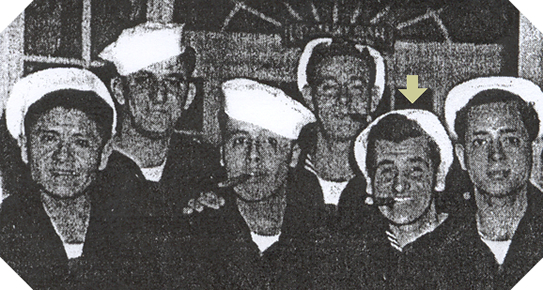Testimony of Angelo Marsella
D-Day veteran

Angelo Marsella was born on March 28, 1925, in Philadelphia, Pennsylvania (USA). Approaching the age of 18 in 1943, he decided to enlist in the Navy and passed physical tests on May 24, 1943, to be accepted. On June 7, 1943, he began intensive training under pouring rain alongside many other recruits at the U.S. Naval Training Center in Bainbridge, Maryland (USA). Here is his account of his days spent in the United States and then around the world, notably off the coast of Normandy on June 6, 1944, aboard the L.S.T. 281…
After the Normandy landings, Angelo Marsella notably participated in Operation Dragoon: the landing in Provence.
“After graduating from Bainbridge Training Base, I was ordered to report to Amphibious Naval Base in Solomons, Maryland, for further naval training.
After completing my time at Navy training bases, I was reassigned to Advance Naval Amphibious Training Base in Little Creek, Virginia, USA, where we slept in four-person tents.
Angelo Marsella’s Logbook. Private Collection
I was subsequently sent aboard a training LST (Landing Ship Tank), but I don’t remember how long we were there. I received training on the LST’s structure and armament. Aboard this ship, we conducted numerous drills concerning the safety of both the ship and the crew.
After completing this training, I was sent to the American Bridge Company in Ambridge, Pennsylvania, to serve on the USS LST 281, which was my home for the remainder of World War II.
After completing the first technical checkout voyage and landing drills, the USS LST 281 was assigned to the theater of operations.
L.S.T. 281 embarks men and equipment at Dartmouth, England. Photo: US National Archives
Based in various ports in southern England, LST 281 was engaged in numerous landing exercises in preparation for the invasion via the French coast. By the end of May 1944, LST 281 had completed its training period. We then received a large number of additional military personnel, including Lieutenant Mitchell Jamieson (Navy Painter), two Navy doctors, 25 pharmacist’s assistants, clearance divers, and soldiers with their equipment.
Lieutenant Jamieson organized simulated casualty transport exercises in the crew quarters.
L.S.T. 281 embarks men and equipment at Dartmouth, England. Photo: US National Archives
On June 2, 1944, LST 281 anchored in the Dart River alongside other LSTs, where we awaited the invasion signal. We knew the invasion would begin on June 5. We then steamed out of Dartmouth Harbor with two American destroyers, two American rescue boats, and other LSTs.
Then we learned of the 24-hour delay to the invasion and circled the English Channel.
On the Dart River at Dartmouth, England, on June 2, 1944, ships await the invasion order (among them the LST 281). Photo : US National Archives
On June 6, 1944, around 3:00 a.m., LST 281 reached the planned area; we were about 6 miles off the Normandy coast. At 3:30 a.m., the clearance diving team descended alongside the LST’s hull using nets, then climbed aboard several LCVPs (Landing Craft Vehicle & Personnel, a landing craft containing approximately 30 equipped soldiers). The job of these frogmen was to locate and remove submerged obstacles.
Due to the presence of these clearance divers aboard LST 281, four other LSTs took the lead of the convoy, behind the minesweepers that were clearing a path for the invasion ships. Outside the path cleared by the minesweepers, the sea was infested with German mines. On the night of June 6th, we were anchored not far from the Normandy coast, and fortunately for us, a British ship warned us that we had lost our anchor, were drifting into a minefield, and needed to find a new anchorage.
Once the clearance divers had departed, we received orders to head toward Utah Beach. The activity aboard LST 281 suddenly became increasingly intense, as did our fear. My battle station was on the port bow, at the 20-millimeter machine gun. I could see the tracer bullets and hear the automatic weapons fire all around us.
LST 281 was getting closer and closer to Utah Beach. I saw numerous bodies of American soldiers floating in the water, as well as several pieces of wreckage.
It was a terrible thing for me to witness such a scene. It really disturbed me, and it still does today. I can still see those soldiers floating in the water. At that precise moment, I was in shock. I felt concerned about the deaths of those men.
I remember saying to my shipmate: Who’s going to help them?
Then I remembered that the two rescue boats accompanying us were responsible for recovering those soldiers, whether they were dead or alive.
In the distance, I saw two flashes of lightning rise in the sky. To my left, I saw the USS Nevada open fire toward the enemy coast with its 400-millimeter guns.
Meanwhile, we were still approaching Utah Beach, and off to the left, I saw a DUKW (amphibious vehicle) hit a mine and sink into the sea. Some time later, I saw a German plane crash near our port side. I wondered: How could it have penetrated our curtain of fire?
At that moment, we were very close to Utah Beach, but we received orders from the Beach Battalion not to land directly on the sand, but to disembark our transport at sea.
During the first few hours, we disembarked the men and equipment we had transported from England. With the presence of numerous waves, the task was not easy. This landing caused considerable damage to our ship, and several of the crew members sustained minor injuries.
Once the cargo of men and equipment was disembarked, LST 281 converted into an auxiliary hospital ship. The first wounded we took on board were from the minesweeper Osprey. She had struck a mine. The U.S.S. Correy, one of our escort ships, also struck a mine. The survivors from both of these ships were severely burned. I remember that some of the soldiers we took on board were very badly injured. I can describe one of these soldiers, who had been hit very violently in the head.
Painting by Navy artist Lt. Jamieson of the wounded being treated aboard L.S.T. 281. Photo: Private collection.
The L.S.T.’s tank hangar was used as a trauma center for the wounded we had embarked.
On June 6, 1944, American wounded were transported aboard L.S.T. 281. Photo: Private collection.
The warships were still firing toward the beach. Overhead, a large number of Allied aircraft were flying toward the enemy shore. The medical team and crew members of LST 281 did their best to ensure the wounded had a comfortable journey to England.
On June 6, 1944, American wounded were transported aboard L.S.T. 281. Photo: Private collection.
On June 9, LST 281 left Southampton Harbor with a full transport of equipped American soldiers on board. At the end of the voyage, we disembarked the transports at Omaha Beach. Once our LST was dry, I walked the beach with some of my comrades and saw more bodies and wreckage than on Utah. We spoke with some American soldiers on the beach. They assured me that they would take care of the bodies of the fallen soldiers. We also told them about the bodies of dead German soldiers we had seen in the beach area. They told us they would simply be covered with earth by bulldozers.
LST 281 made five voyages to deliver reinforcements of men and equipment. A lot happened on D-Day, but this is what I remember.”
Angelo Marsella
![]()







